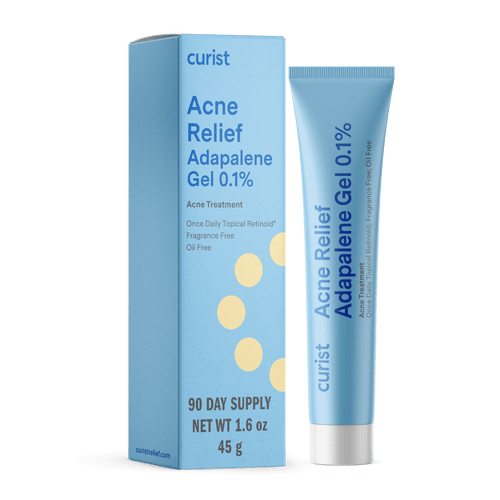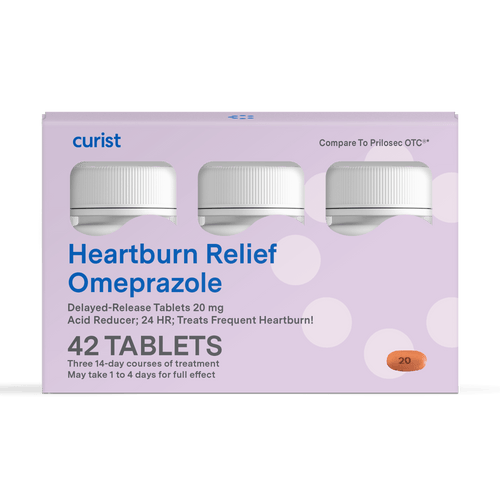By Ange Lu, The University of Texas at Austin College of Pharmacy
Curist delivers medicine to your door at a fraction of the price of traditional brands. We hope everyone stays safe and healthy during this time.
Have you ever wondered about the difference between adapalene and salicylic acid to treat acne? You’ve probably seen them from the corner of your eye as you brush through the skincare aisle or heard about them through friends, beauty gurus, or influencers. But what are adapalene and salicylic acid, really? You’re in luck because Curist is here to break it down for you!
Are Adapalene and Salicylic Acid the Same Thing?
Adapalene and salicylic acid are not the same thing! Both are used to treat acne, but they work in different ways. Adapalene fights acne from the inside out while salicylic acid only tackles acne on the surface of the skin.
The main ingredient in Curist Acne Relief, adapalene is a topical retinoid that has vitamin A activity, which helps increase skin cell turnover rates to clear clogged pores and prevent blackheads and whiteheads. Regulating the turnover rate encourages the exfoliation of older skin cells so newer ones can grow, making adapalene well-known for its anti-aging benefits and ability to improve the texture of your skin. Adapalene has also been long touted by dermatologists for its anti-inflammatory properties to lessen any redness and irritation from acne.
On the other hand, salicylic acid is a topical beta hydroxy acid that chemically exfoliates the surface of your skin to remove dead skin cells and unclog pores. Higher concentrations of salicylic acid may cause a peeling effect. Due to its drying abilities, many people turn to salicylic acid for oil control. As a note, because salicylic acid is chemically similar to aspirin, people with an aspirin allergy should not use salicylic acid.
What are the Differences Between Salicylic Acid vs Adapalene?
Adapalene and salicylic acid are both used to treat acne, but there are a few differences between them. Let’s break it down!
Adapalene: A Topical Retinoid
The main ingredient in Curist Acne Relief, adapalene is a topical retinoid that treats and prevents acne at the source by promoting cell turnover. Cell turnover is the life cycle of your skin cell. New cells deep in your skin push out older “dead” skin cells to the surface as they grow. In faster cell turnover rates, your skin heals quicker and looks smoother, clearer, and healthier as new cells replace older ones. However, as you age, your cell turnover rate naturally slows, causing dead skin cells to build up. As a result, your pores may get blocked and cause acne. Adapalene helps increase the skin cell turnover rate to unclog pores and prevent acne from forming in the first place. Through this same process, adapalene has anti-aging abilities to improve the texture of your skin. As an added bonus, adapalene also has anti-inflammatory properties to reduce redness and irritation!
Adapalene vs Other Retinoids
Compared to other retinoids, adapalene (the main ingredient in Curist Acne Relief) is the best choice for people with sensitive skin and is available as a gel over-the-counter at Curist. Adapalene can also come in a cream or lotion as a prescription. Adapalene should be used once a day after gently cleaning your skin and patting it dry. Your skin and acne will get irritated during the first few weeks of using adapalene before you see results. Adapalene’s full effects are usually seen 8 to 12 weeks after starting, so it’s important to remember to keep going and be consistent with applying!
Individuals should make sure that adapalene does not come into contact with the eyes, lips, and mouth and should avoid using it during pregnancy or while breastfeeding.
Salicylic Acid
Salicylic acid is a topical beta hydroxy acid that only works on the outer layer of your skin to remove dead skin cells and excess oil clogging your pores. Rather than promoting cell turnover, salicylic acid causes drying to decrease oil secretion and a peeling effect to chemically exfoliate your skin. Because of salicylic acid’s drying effect, it is usually beneficial for people with oily skin.
Salicylic acid is available as a cleanser or topical gel over the counter. Salicylic acid should be used 1 to 2 times a day after gently cleaning your skin and patting it dry. Similar to adapalene, salicylic acid will also cause your skin and acne to be irritated during the first few weeks of use, but salicylic acid’s effects are usually seen after applying for 4 to 6 weeks.
Additionally, because salicylic acid is structurally similar to aspirin, people with an aspirin allergy should not use salicylic acid. People with diabetes or poor blood circulation should also avoid using salicylic acid.
Is Adapalene More Effective than Salicylic Acid for Acne? Is Salicylic Acid More Effective than Adapalene?
The main ingredient in Curist Acne Relief, adapalene is more effective than salicylic acid for acne. According to the American Academy of Family Physicians, adapalene can be used for mild to moderate acne while salicylic acid is only used for more mild acne. Salicylic acid is less effective than adapalene but more affordable compared to brand name adapalene products, such as Differin or La Roche-Posay.
If you want to learn more about the difference between adapalene products, read our Curist article Adapalene vs. Differin vs. La RochePosay: Acne Treatment.
You should always consult with a dermatologist and choose a product that works best for you and your skin. We recommend Curist Acne Relief, which contains adapalene, to meet your skin and budget needs!
Is Adapalene Stronger than Salicylic Acid? What about Benzoyl Peroxide?
According to the American Academy of Family Physicians, salicylic acid is less effective than adapalene (the main ingredient in Curist Acne Relief) and is usually used for mild acne. Adapalene can be used for both mild and moderate acne and is often turned to when using just salicylic acid isn’t effective. Adapalene is typically used in combination with topical antibiotics or benzoyl peroxide in moderate cases of acne.
For more moderate and severe acne, benzoyl peroxide, azelaic acid, and/or oral antibiotics may be prescribed by your dermatologist. If you want to learn more about adapalene and azelaic acid, check out our blog post Adapalene vs. Azelaic Acid.
What’s Best for Whiteheads & Blackheads: Adapalene vs Salicylic Acid?
The main ingredient in Curist Acne Relief, adapalene is best for whiteheads and blackheads compared to salicylic acid. Adapalene works by promoting cell turnover, where new cells under your skin push out older skin cells to the surface as they grow. In slower cell turnover rates, dead skin cells will quickly accumulate and clog your pores to form whiteheads and blackheads. Adapalene helps regulate cell turnover to prevent whiteheads and blackheads from forming in the first place.
What’s Best for Wrinkles: Salicylic Acid vs Adapalene for Wrinkles?
Compared to salicylic acid, adapalene works best for wrinkles. Adapalene is a topical retinoid, which is a vitamin A derivative known for its anti-aging benefits and ability to reduce fine lines and wrinkles. Adapalene increases skin cell turnover to help exfoliate the skin, so that the newer, healthier skin cells can replace your older ones.
For more on adapalene and its anti-aging properties, read Is Adapalene Good for Anti-Aging?
Can I Use Adapalene and Salicylic Acid Together or on the Same Day?
You should avoid using adapalene and salicylic acid together because it can make your skin more irritated and cause drying, flaking, and redness. Adding two exfoliating products together is a lot for your skin to handle! For that same reason, you should avoid using adapalene and salicylic acid on the same day.
Instead, you should use only one acne treatment that works best for you and your skin! We recommend Curist Acne Relief, which contains adapalene 0.1%.












